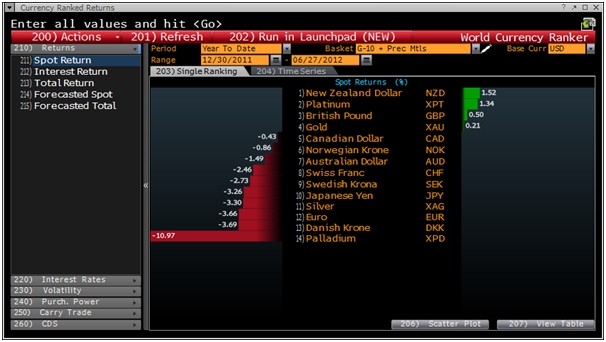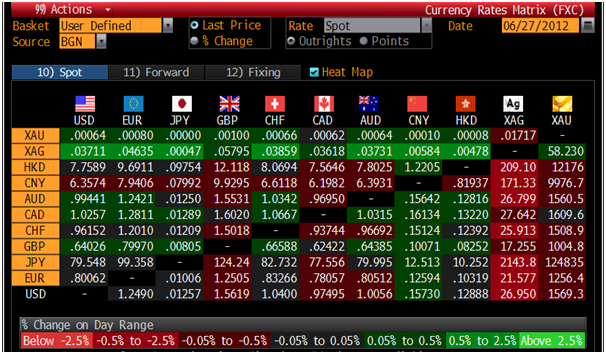Today's AM fix was USD 1,567.50, EUR 1,255.31, and GBP 1,003.39 per ounce.
Yesterday’s AM fix was USD 1,583.25, EUR 1,267.41, and GBP 1,013.73 per ounce.
Gold fell $11.90 or 0.9% and closed at $1,573.75/oz yesterday. Gold initially rose prior to gradual easing and that selling pressure increased soon after the open in Europe. Long-term support is at $1,530/oz and resistance is at $1,640/oz.
Gold will likely be supported again at these levels due to the near certainty that European leaders will fail to come up with concrete measures to solve the region's debt crisis at this week's summit.
Geopolitical risk from the Middle East and the growing Turkey and Syria tensions may also support gold. Hawkish and bellicose words from Turkish leaders continue and Turkey has warned of possible military retaliation against any threat by Syrian forces near its border. Reuters reported yesterday that Turkey was mobilising its forces on the Syrian border.
Periphery debt markets have seen a meagre relief rally today but the Spanish and Italian 10 year remain near 7% and over 6%. Gold is higher in most major currencies year to date but has surged against the rupee as the Indian rupee hit a record low against major currencies last week.
Indian gold prices are soaring despite official attempts to curtail demand. In March the Indian government doubled the import duty on gold to 4% in attempts to rectify significant trade deficits and thereby help protect the currency. There are now reports that the Reserve Bank of India (RBI) is likely to clamp down on gold bullion coin sales by banks as the rising bullion imports are adding pressure to the current account deficit and weakening the rupee.
Western central banks and mints will not be clamping down on gold bullion coin sales in the near future as demand for gold and silver bullion coins fell in Q1 2012. Demand for gold coins fell in key markets in the early part of this year as the strong demand for 1 ounce coins and bars fell due to less safe haven demand.
The United States, Canadian and Austrian Mints, which between them produce three of the world's top five bullion investment coins, all reported lower sales in the first quarter of 2012 versus a year ago. Combined sales of U.S. American Eagle, Canadian Maple Leaf and Vienna Philharmonic gold coins fell by more than a third to 451,113 ounces in the three months to March.
While demand has indeed fallen, the scale of the far from resolved eurozone and wider debt crisis means that this decline in demand is likely to reverse again in the coming months. The decline is part of the peak and trough of demand seen in recent years.
Gold’s safe haven status will soon again be realized and universally accepted. Repeated simplistic assertions that gold is a bubble will be seen as misguided and imprudent. This is assured as we live in an era where assets previously considered risk free, such as U.S. Treasurys and German Bunds, are increasingly being questioned.
Egan-Jones Ratings yesterday lowered Germany's sovereign rating on expectations that the country will be left with significant uncollectable receivables due to its exposure to the eurozone. Egan-Jones has often been ahead of the curve in terms of sovereign credit downgrades and the other rating agencies are likely to follow.
"Whether or not Greece and other EMU members exit, Germany will be left with massive, additional, uncollectible receivables," the agency said. It put the potential direct and indirect exposure at 2.9 trillion euros, which would raise the country's ratio of debt to GDP to a high 114 percent. It said investors are worried about the burden that could be foisted upon Germany by greater deterioration of the eurozone at-large.
"Our major fear is Germany will be expected to provide indirect financial support to weaker EU banks over the next couple of years to ameliorate asset quality problems and replace fleeing deposits.”
If "risk free" European debt and even German bunds are no longer without risk, it will reverberate throughout all markets (bonds, equities, currencies, gold etc) globally, creating an increase in relative risk levels and a consequent adjustment of investment values. It means that the record low interest rates of recent years will be no more.
Paper assets and fiat currencies look set to continue to fall against the finite and immutable currency that is gold. Especially as the risks of a global currency war and global competitive currency devaluations remains real.
Continual short-term panaceas by misguided policy makers doing the bidding of powerful banks has delayed the day of reckoning. However, there is no such thing as a free lunch and the failure to tackle the root cause of the problem, which is insolvency through too much debt, means that the day of reckoning will be of orders of magnitude greater had more rational policies been implemented. Gold buying remains steady but surprisingly subdued given the scale of the crisis.
There remains a fundamental failure to comprehend the scale of the crisis and a blind belief that the world will return to its pre crisis state soon. This fails to appreciate that the pre crisis state of the world, with massive and unprecedented levels of debt in the U.S., the U.K. and most western economies was anything but normal.
Other News
(Bloomberg) -- Societe Generale Says Global Gold Hedge Book Fell 3 Tons in Q1
The global gold hedge book declined by 3 metric tons to 158 tons in the first quarter, Societe Generale SA said, which produced the study with Thomson Reuters GFMS. “Reductions in the book will be sparse from now onwards,” it said.
(Bloomberg) -- Disinflationary Environment "Difficult" for Gold, WGC Says
Slowing inflation is “difficult” for all asset classes including gold, which was sold recently as a source of liquidity, according to the World Gold Council. Gold was sold as the market reacted to dashed expectations for coordinated quantitative easing by the world’s central banks, Marcus Grubb, managing director for investment research, said today in a Bloomberg Television interview in Hong Kong.
The precious metal has lost 5.7 percent since March 30, the worst performance since the three months to September 2008. An intensifying debt crisis in Europe will cut global economic expansion to 2.5 percent in 2012 from 2.9 percent last year, according to economists surveyed by Bloomberg. China, the world’s biggest consumer of raw materials, may post the slowest growth in 13 years, a Bloomberg News survey showed last month.
“Deflation and disinflationary forces are at large again in the world economy,” Grubb said. “In that kind of scenario, people move into cash, they move into Treasurys, they move into U.S. dollars as a safe haven.”
Still, gold’s fundamentals continue to get stronger as “the jury is still out” on future events such as the U.S. debt-ceiling debate and presidential election and a “fiscal cliff” to be dealt with before the end of this year, he said.
“We are pretty confident to see a stronger second half for the gold market,” Grubb said.
In the long-term, the challenge “is if we see a return to more normal economic conditions -- interest rates rising again and real interest rates being established,” Grubb said. “A return to positive real interest rates seems a long way off.”
(Bloomberg) -- Russia Boosts Gold Reserves to Highest Since at Least 1993
Russia expanded its gold holdings by 15.5 metric tons valued at $790.7 million last month to the highest level since at least 1993 as central banks are buying more of the metal to diversify their international reserves.
Russia more than doubled its bullion holdings in the past five years to 911.3 tons in May, when gold averaged $1,587.68 an ounce, data on the International Monetary Fund’s website showed. Turkey’s reserves rose 5.7 tons to 245 tons, Ukraine’s climbed 2.1 tons to 32.7 tons and Kazakhstan boosted them by 1.8 tons to 100 tons, the data show.
Central banks are expanding reserves after the metal climbed the past 11 years and holdings in exchange-traded products are near an all-time high set in March. The banks may buy more bullion this year than the purchases of about 456 tons in 2011 as countries diversify their reserves, Ashish Bhatia, the manager of government affairs at the World Gold Council, said in a June 19 interview in New York. Prices slid 6.3 percent in May, the most this year.
“These dips give them an opportunity to top up,” said Dan Smith, a commodities analyst at Standard Chartered Plc in London. “The momentum is pretty strong from central banks heading into gold and I don’t see anything in the near future that’s going to reverse that. There’s a general perception that currencies are not quite as solid as they were seen.”
Russia’s Reserves
Russia’s bullion reserves expanded by 94.3 tons last year, according to the IMF. The 911.3 tons the nation now holds is the most since at least 1993, when IMF data tracking Russian figures begins. It was the fourth-biggest producer of the metal with output of 211.9 tons, according to London-based Thomson Reuters GFMS.
Gold for immediate delivery traded at $1,584.47 by 11:43 a.m. in London and is up 1.3 percent this year. Prices slumped in May as concern about Europe’s debt crisis boosted the dollar and cut the metal’s appeal as an alternative asset. Bullion reached a record $1,921.15 in September.
Turkey has allowed banks to hold more of their reserves in gold to provide extra liquidity. The central bank this month raised the proportion of reserve requirements that can be held in foreign exchange to 50 percent from 45 percent, while the limit for gold was increased to 25 percent from 20 percent. The changes will add as much as $2.2 billion to gold reserves.
Gold accounts for about 9.1 percent of Russia’s total reserves, 5.1 percent of Ukraine’s and 15 percent of Kazakhstan’s, according to the World Gold Council. That compares with more than 70 percent for the U.S. and Germany, the biggest bullion holders, the data show.
Kazakhstan Adds
Kazakhstan plans to raise the amount of gold it holds as part of its reserves to 20 percent, Bisengaly Tadzhiyakov, deputy chairman of the country’s central bank, said earlier this month.
“The official sector continues its gold accumulation in part to diversify its foreign reserves,” said Bayram Dincer, an analyst at LGT Capital Management in Pfaeffikon, Switzerland. “We expect that the official sector will appear again as a dominant net buyer this year. This new trend will continue in the years ahead.”
Bloomberg competes with Thomson Reuters in selling financial and legal information and trading systems.
(Bloomberg) -- Russian Five-Month Total Gold Output Declines 2.9% to 58.6 Tons
Russian gold output from mining and other production fell 2.9 percent in January through May, according to the Gold Producers’ Union.
Gold mining dropped to 58.6 metric tons from 60.3 tons in the first five months of last year on a planned decline at Kinross Gold Corp.’s mine in the Chukotka region in Russia’s Far East, the union said today in an e-mailed statement. Total output in the first four months of the year declined 0.9 percent to 44.96 tons, the union said on May 30.
(Bloomberg) -- Gold Prices Poised to Gain 6% in 2012 on Central Bank Purchases
Gold may average $1,660 an ounce, 6 percent higher than over the last year, as volatility in the U.S. dollar and euro boosts demand from central banks, Australia’s Bureau of Resources and Energy Economics said. Exports from Australia will increase 9 percent 361 metric tons in the year starting July 1, the bureau said today, maintaining its March forecast.
National production will increase to 283 tons from 261 tons a year earlier as Newcrest Mining Ltd., the country’s largest gold miner, boosts output from its Cadia East operation, it said. Exports consist of refined metal from domestic mines and imports of so-called dore, or impure gold, and scrap, which are shipped in, refined into bullion and then re-exported, the bureau said. World gold mine production will increase to 2,907 tons in calendar 2012 from 2,818 tons a year earlier, it said.
Central banks have increased purchases to diversify their assets as the metal has climbed the past 11 years. The banks may buy more this year than the 456 tons bought in 2011, Ashish Bhatia, the manager of government affairs at the World Gold Council, said June 19.
Russia more than doubled its bullion holdings in the past five years to 911.3 tons in May, data on the International Monetary Fund’s website showed. Turkey’s reserves rose 5.7 tons to 245 tons, Ukraine’s climbed 2.1 tons to 32.7 tons and Kazakhstan boosted them by 1.8 tons to 100 tons, the data show.
Gold for immediate delivery was little changed at $1,572.78 an ounce at 11:53 a.m. in Singapore after falling 0.7 percent yesterday. The euro has lost 3.6 percent against the dollar this year, as Europe struggled to resolve its sovereign-debt crisis.
- English (UK)
- English (India)
- English (Canada)
- English (Australia)
- English (South Africa)
- English (Philippines)
- English (Nigeria)
- Deutsch
- Español (España)
- Español (México)
- Français
- Italiano
- Nederlands
- Português (Portugal)
- Polski
- Português (Brasil)
- Русский
- Türkçe
- العربية
- Ελληνικά
- Svenska
- Suomi
- עברית
- 日本語
- 한국어
- 简体中文
- 繁體中文
- Bahasa Indonesia
- Bahasa Melayu
- ไทย
- Tiếng Việt
- हिंदी
Gold Bides Time As 'Risk Free' German Debt Downgraded
Published 06/27/2012, 08:19 AM
Updated 07/09/2023, 06:31 AM
Gold Bides Time As 'Risk Free' German Debt Downgraded
Latest comments
Loading next article…
Install Our App
Risk Disclosure: Trading in financial instruments and/or cryptocurrencies involves high risks including the risk of losing some, or all, of your investment amount, and may not be suitable for all investors. Prices of cryptocurrencies are extremely volatile and may be affected by external factors such as financial, regulatory or political events. Trading on margin increases the financial risks.
Before deciding to trade in financial instrument or cryptocurrencies you should be fully informed of the risks and costs associated with trading the financial markets, carefully consider your investment objectives, level of experience, and risk appetite, and seek professional advice where needed.
Fusion Media would like to remind you that the data contained in this website is not necessarily real-time nor accurate. The data and prices on the website are not necessarily provided by any market or exchange, but may be provided by market makers, and so prices may not be accurate and may differ from the actual price at any given market, meaning prices are indicative and not appropriate for trading purposes. Fusion Media and any provider of the data contained in this website will not accept liability for any loss or damage as a result of your trading, or your reliance on the information contained within this website.
It is prohibited to use, store, reproduce, display, modify, transmit or distribute the data contained in this website without the explicit prior written permission of Fusion Media and/or the data provider. All intellectual property rights are reserved by the providers and/or the exchange providing the data contained in this website.
Fusion Media may be compensated by the advertisers that appear on the website, based on your interaction with the advertisements or advertisers.
Before deciding to trade in financial instrument or cryptocurrencies you should be fully informed of the risks and costs associated with trading the financial markets, carefully consider your investment objectives, level of experience, and risk appetite, and seek professional advice where needed.
Fusion Media would like to remind you that the data contained in this website is not necessarily real-time nor accurate. The data and prices on the website are not necessarily provided by any market or exchange, but may be provided by market makers, and so prices may not be accurate and may differ from the actual price at any given market, meaning prices are indicative and not appropriate for trading purposes. Fusion Media and any provider of the data contained in this website will not accept liability for any loss or damage as a result of your trading, or your reliance on the information contained within this website.
It is prohibited to use, store, reproduce, display, modify, transmit or distribute the data contained in this website without the explicit prior written permission of Fusion Media and/or the data provider. All intellectual property rights are reserved by the providers and/or the exchange providing the data contained in this website.
Fusion Media may be compensated by the advertisers that appear on the website, based on your interaction with the advertisements or advertisers.
© 2007-2024 - Fusion Media Limited. All Rights Reserved.
